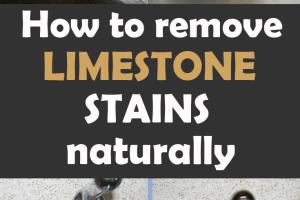Ultimate Guide to Effectively Remove Limestone Stains

-
Quick Links:
- Introduction
- Understanding Limestone
- Common Sources of Limestone Stains
- Preventing Limestone Stains
- Removal Techniques
- Homemade Cleaning Solutions
- Commercial Cleaning Products
- Case Studies
- Expert Insights
- FAQs
Introduction
Limestone is a popular choice for flooring, countertops, and outdoor spaces due to its natural beauty and durability. However, its porous nature makes it susceptible to stains from various sources. This guide aims to equip you with the knowledge to effectively remove limestone stains, ensuring your surfaces remain pristine.
Understanding Limestone
Limestone is a sedimentary rock composed primarily of calcium carbonate. Its unique properties make it a favored material in construction and interior design. However, its porous structure can lead to staining from spills, dirt, and other contaminants. Understanding this material is crucial for effective care and maintenance.
Characteristics of Limestone
- Porosity: Limestone's porous nature makes it susceptible to water and oil absorption.
- Softness: Being softer than granite and marble, limestone can scratch easily.
- Color Variations: Available in various colors, it can be affected differently by stains depending on its hue.
Common Sources of Limestone Stains
Identifying the sources of stains is the first step in addressing them. Here are some common culprits:
- Food and Beverage Spills: Wine, coffee, and acidic foods can leave stubborn stains.
- Oil and Grease: Kitchen countertops are particularly vulnerable to grease stains.
- Water Damage: Hard water can leave mineral deposits, leading to discoloration.
- Rust: Metal furniture and fixtures can cause rust stains on limestone.
Preventing Limestone Stains
Preventive measures can save you from the hassle of stain removal. Here are some effective strategies:
- Sealing: Apply a high-quality limestone sealer to create a protective barrier.
- Immediate Cleanup: Wipe up spills promptly to reduce staining potential.
- Coasters and Mats: Use coasters for drinks and mats in high-traffic areas to minimize wear.
Removal Techniques
When stains do occur, employing the right removal techniques is essential. Follow these steps for effective stain removal:
Step 1: Identify the Stain Type
Understanding the nature of the stain will guide your removal method. For example:
- Organic stains: Such as food and drink.
- Inorganic stains: Such as rust.
Step 2: Prepare the Area
Clear the area of furniture and debris to work effectively.
Step 3: Choose the Right Method
- Blotting: For liquid stains, blot (do not rub) with a clean cloth.
- Scrubbing: Use a soft-bristled brush for tougher stains.
- Applying Solutions: Use appropriate cleaning solutions based on the stain type.
Homemade Cleaning Solutions
Several effective homemade solutions can help remove limestone stains:
Baking Soda Paste
Mix baking soda with water to form a paste. Apply it to the stain, let it sit for 10-15 minutes, then scrub gently.
Vinegar Solution
Mix equal parts vinegar and water. Apply to stains from food or drink but rinse quickly to avoid damage.
Commercial Cleaning Products
When homemade solutions aren’t enough, consider these commercial products:
- StonePro: Specializes in stone care products.
- DuPont: Offers a line of stain removers specifically for natural stone.
Case Studies
Real-world examples can illustrate the effectiveness of various techniques:
Case Study 1: Kitchen Countertops
A family found red wine stains on their limestone countertop. They applied a baking soda paste and, after 20 minutes, the stains were significantly reduced.
Case Study 2: Outdoor Patios
Rust stains from metal furniture on limestone patio tiles were removed using a commercial rust remover, followed by sealing the surface to prevent future stains.
Expert Insights
We consulted with stone care professionals to gather insights on limestone maintenance:
- Regular Sealing: Experts recommend sealing limestone every 6-12 months.
- Professional Cleaning: For tough stains, consider hiring a professional service.
FAQs
Here are some frequently asked questions regarding limestone stain removal:
1. Can I use bleach on limestone?
No, bleach can damage limestone. It's best to avoid harsh chemicals.
2. How often should I seal my limestone?
Every 6-12 months, depending on usage and exposure to stains.
3. What is the best way to remove oil stains?
Use a degreaser or a mixture of baking soda and water to absorb the oil.
4. Are there specific products for rust stains?
Yes, there are commercial rust stain removers designed for natural stone.
5. Can I use a pressure washer on limestone?
It's not recommended as the high pressure can damage the stone.
6. How do I know if my limestone is sealed?
Perform a water test; if water beads up, it's sealed well.
7. Is vinegar safe for limestone cleaning?
Vinegar can etch limestone; use it with caution and always rinse afterward.
8. What are the signs of limestone discoloration?
Common signs include dark spots, lighter or uneven patches, often caused by spills.
9. Can I use a steam cleaner on limestone?
Steam cleaners can be used, but ensure the heat is not too high to avoid damage.
10. What should I do if stains persist?
Consider consulting a professional cleaner for severe or persistent stains.
Random Reads